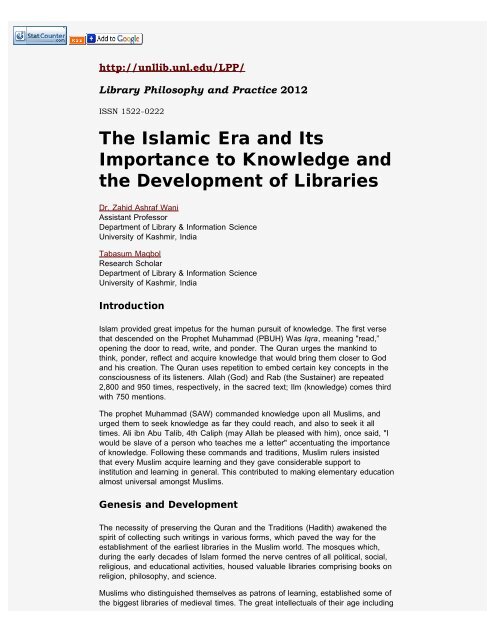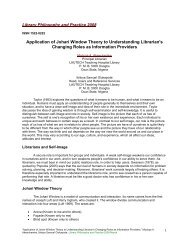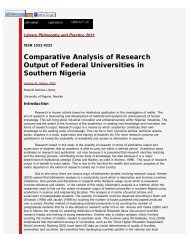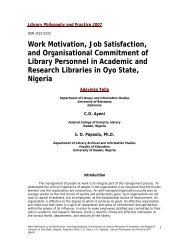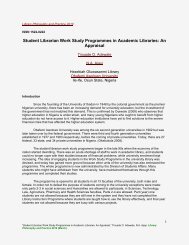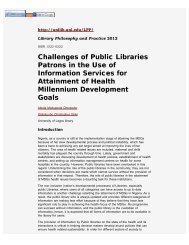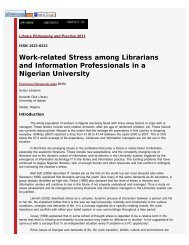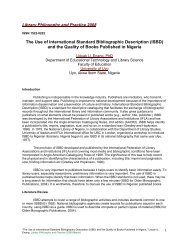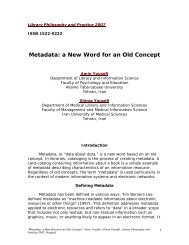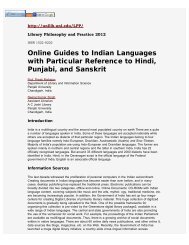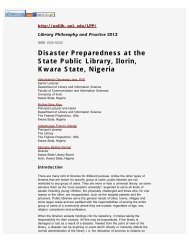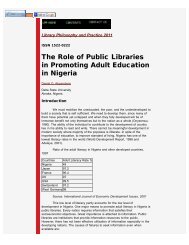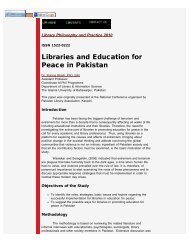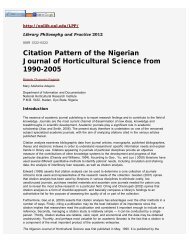The Islamic Era and Its Importance to Knowledge - University of Idaho
The Islamic Era and Its Importance to Knowledge - University of Idaho
The Islamic Era and Its Importance to Knowledge - University of Idaho
You also want an ePaper? Increase the reach of your titles
YUMPU automatically turns print PDFs into web optimized ePapers that Google loves.
http://unllib.unl.edu/LPP/Library Philosophy <strong>and</strong> Practice 2012ISSN 1522-0222<strong>The</strong> <strong>Islamic</strong> <strong>Era</strong> <strong>and</strong> <strong>Its</strong><strong>Importance</strong> <strong>to</strong> <strong>Knowledge</strong> <strong>and</strong>the Development <strong>of</strong> LibrariesDr. Zahid Ashraf WaniAssistant Pr<strong>of</strong>essorDepartment <strong>of</strong> Library & Information Science<strong>University</strong> <strong>of</strong> Kashmir, IndiaTabasum MaqbolResearch ScholarDepartment <strong>of</strong> Library & Information Science<strong>University</strong> <strong>of</strong> Kashmir, IndiaIntroductionIslam provided great impetus for the human pursuit <strong>of</strong> knowledge. <strong>The</strong> first versethat descended on the Prophet Muhammad (PBUH) Was Iqra, meaning "read,”opening the door <strong>to</strong> read, write, <strong>and</strong> ponder. <strong>The</strong> Quran urges the mankind <strong>to</strong>think, ponder, reflect <strong>and</strong> acquire knowledge that would bring them closer <strong>to</strong> God<strong>and</strong> his creation. <strong>The</strong> Quran uses repetition <strong>to</strong> embed certain key concepts in theconsciousness <strong>of</strong> its listeners. Allah (God) <strong>and</strong> Rab (the Sustainer) are repeated2,800 <strong>and</strong> 950 times, respectively, in the sacred text; Ilm (knowledge) comes thirdwith 750 mentions.<strong>The</strong> prophet Muhammad (SAW) comm<strong>and</strong>ed knowledge upon all Muslims, <strong>and</strong>urged them <strong>to</strong> seek knowledge as far they could reach, <strong>and</strong> also <strong>to</strong> seek it alltimes. Ali ibn Abu Talib, 4th Caliph (may Allah be pleased with him), once said, "Iwould be slave <strong>of</strong> a person who teaches me a letter" accentuating the importance<strong>of</strong> knowledge. Following these comm<strong>and</strong>s <strong>and</strong> traditions, Muslim rulers insistedthat every Muslim acquire learning <strong>and</strong> they gave considerable support <strong>to</strong>institution <strong>and</strong> learning in general. This contributed <strong>to</strong> making elementary educationalmost universal amongst Muslims.Genesis <strong>and</strong> Development<strong>The</strong> necessity <strong>of</strong> preserving the Quran <strong>and</strong> the Traditions (Hadith) awakened thespirit <strong>of</strong> collecting such writings in various forms, which paved the way for theestablishment <strong>of</strong> the earliest libraries in the Muslim world. <strong>The</strong> mosques which,during the early decades <strong>of</strong> Islam formed the nerve centres <strong>of</strong> all political, social,religious, <strong>and</strong> educational activities, housed valuable libraries comprising books onreligion, philosophy, <strong>and</strong> science.Muslims who distinguished themselves as patrons <strong>of</strong> learning, established some <strong>of</strong>the biggest libraries <strong>of</strong> medieval times. <strong>The</strong> great intellectuals <strong>of</strong> their age including
Ibn Rushid (Avicenna) the encyclopedist, Ibn Miskawayah, the his<strong>to</strong>rianphilosopher,Al-Fadl Ibn Naubakht <strong>and</strong> Humayun Ibn Ishaq, the renownedtransla<strong>to</strong>rs, who were entrusted with the responsibility for the organisation <strong>and</strong>maintenance <strong>of</strong> libraries.Under the Abbasids, Muslims formed the vanguard <strong>of</strong> civilization. <strong>The</strong> Abbasidswere influenced by the Quran <strong>and</strong> Hadith such as, "the ink <strong>of</strong> scholar is equal <strong>to</strong>the blood <strong>of</strong> martyr," stressing the value <strong>of</strong> knowledge. During this period theMuslim world became the unrivalled intellectual centre for science, philosophy,medicine, <strong>and</strong> education as the Abbasids championed the cause <strong>of</strong> knowledge <strong>and</strong>established Darul Hukama (House <strong>of</strong> Wisdom) in Baghdad, founded by greatAbbasid Caliph Harun-ar-Rashid, which was divided in<strong>to</strong> two sections, one wasconcerned with the translation work <strong>and</strong> the other related <strong>to</strong> the collection <strong>of</strong> books<strong>and</strong> housing a big library (Gregorian, 2003a). During this time every part <strong>of</strong> theglobe was ransacked by the agents <strong>of</strong> the caliphs for the hoarded wealth <strong>of</strong>antiquity. Yahya Barmeki, the famous gr<strong>and</strong> Minister <strong>of</strong> Harun, had summonedwell known scholars from distant l<strong>and</strong>s, who adorned the literary gatherings <strong>of</strong> theCaliph. Harun-ar-Rashid appointed Al-Fadl Ibn Naubakht, a renowned scholar <strong>and</strong>transla<strong>to</strong>r, as head <strong>of</strong> the library in Darul Hukama. <strong>The</strong> library contained a largenumber <strong>of</strong> books which were efficiently arranged <strong>and</strong> catalogued (Gregorian,2003b)In addition <strong>to</strong> the library <strong>of</strong> the House <strong>of</strong> Wisdom, there were many other librariesin Baghdad attached <strong>to</strong> the many faith schools (Madaris); each containedthous<strong>and</strong>s <strong>of</strong> books <strong>and</strong> manuscripts. <strong>The</strong>re were also private individual libraries,which were not open <strong>to</strong> the general public, but were available <strong>to</strong> scientists,philosophers, researchers <strong>and</strong> writers (Ma'rouf, 1968). On the same pattern, incities <strong>of</strong> the eastern provinces <strong>of</strong> <strong>Islamic</strong> world, several "Houses <strong>of</strong> <strong>Knowledge</strong>"(Darul Al-Ilm) were established in the 9th <strong>and</strong> 10th centuries <strong>to</strong> emulate that <strong>of</strong>Darul Hakkama in Baghdad. Such cities include Mosul, Basra, Shiraz, Rayy, etc.(Jawad <strong>and</strong> Susa, 1958)<strong>The</strong>re were similar libraries in Cairo, Aleppo, <strong>and</strong> the major cities <strong>of</strong> Iran <strong>and</strong>Central Asia (Bon, 1884). Spain alone had seventy public libraries (L<strong>and</strong>au, 1967).Writing on the Muslim Spanish libraries Scott (1904) writes:Nor must the libraries be omitted from this list <strong>of</strong> those fac<strong>to</strong>rs <strong>of</strong>progress which so signally contributed <strong>to</strong> the public enlightment <strong>and</strong><strong>to</strong> the formation <strong>of</strong> national character. <strong>The</strong>re was no city <strong>of</strong>importance without at least one <strong>of</strong> these treasure houses <strong>of</strong> literature.<strong>The</strong>ir shelves were open <strong>to</strong> every applicant. Catalogues facilitated theexamination <strong>of</strong> the collections <strong>and</strong> the classification <strong>of</strong> the varioussubjects. Many <strong>of</strong> the volumes were enriched with illuminations <strong>of</strong>wonderful beauty; the more precious were bound in the embossedleather <strong>and</strong> fragrant woods; some were inlaid with gold <strong>and</strong> silver.Here were <strong>to</strong> be found all the learning <strong>of</strong> the past <strong>and</strong> all thediscoveries <strong>of</strong> the present age, the philosophy <strong>of</strong> Athens, theastronomy <strong>of</strong> Babylon, the science <strong>of</strong> Alex<strong>and</strong>ria, the results <strong>of</strong>prolonged observation <strong>and</strong> experiment on the <strong>to</strong>wers <strong>and</strong> in thelabora<strong>to</strong>ries <strong>of</strong> Cordoba <strong>and</strong> Seville.A major innovation <strong>of</strong> this period was paper, originally a secret tightly guarded byChinese. <strong>The</strong> art <strong>of</strong> papermaking was obtained from prisoners taken at the Battle<strong>of</strong> Talas, resulting in<strong>to</strong> paper mills being built in Samark<strong>and</strong> <strong>and</strong> Baghdad. <strong>The</strong>Arabs improved upon the Chinese techniques <strong>of</strong> using mulberry bark by usingstarch <strong>to</strong> account for the Muslim preference for pen vs. the Chinese for brushes(Pacey, 1990a). By the end <strong>of</strong> the 9th century there were hundreds <strong>of</strong> shopsemploying scribes <strong>and</strong> binders for books in Baghdad <strong>and</strong> even public librariesbegan <strong>to</strong> be established, including the first lending libraries. From here papermaking spread west <strong>to</strong> Al-Andalus <strong>and</strong> from there <strong>to</strong> Europe in the 13th century(Pacey, 1990b).
Mackensen <strong>and</strong> Pin<strong>to</strong> (1929) have written extensively on <strong>Islamic</strong> libraries <strong>of</strong> themiddle ages, highlighting their place <strong>and</strong> role in <strong>Islamic</strong> society. So widespreadwere public book collections that it was impossible <strong>to</strong> find a mosque or a learninginstitute <strong>of</strong> any sort, throughout the l<strong>and</strong> <strong>of</strong> Islam, without a collection <strong>of</strong> booksplaced at the disposal <strong>of</strong> students or readers.By the 10th century, Cordoba had 70 libraries, the largest <strong>of</strong> which had 600,000books, while as many as 60,000 treatises, poems, polemics <strong>and</strong> compilations werepublished each year in Al-Andalus (Da<strong>to</strong>, 2005). <strong>The</strong> library <strong>of</strong> Cairo had morethan 100,000 books, while they library <strong>of</strong> Tripoli is said <strong>to</strong> have had as many asthree million books, before it was burnt during the crusades (Draper, 1878). <strong>The</strong>number <strong>of</strong> important <strong>and</strong> original Arabic works on science that have survived ismuch larger than the combined <strong>to</strong>tal <strong>of</strong> Greek <strong>and</strong> Latin works on science(Swerdlow, 1993).It was the practice <strong>to</strong> appoint a librarian <strong>to</strong> take charge <strong>of</strong> the affairs <strong>of</strong> the library(Provencal, n.p.). Such duty was only for the most learned amongst men, those <strong>of</strong>unusual attainment; as cus<strong>to</strong>dians <strong>of</strong> the libraries (Mackensen, (a) 1935). <strong>The</strong>management <strong>of</strong> the Almohad libraries, says Ibn Farhun, was one <strong>of</strong> the privilegedstate positions, for which were selected only the best scholars (Deverdun, 1959).<strong>The</strong> Librarian <strong>of</strong> gr<strong>and</strong> mosque <strong>of</strong> Aleppo library had Muhammad al-Qasarani, anaccomplished poet <strong>and</strong> a man well versed in literature, geometry, arithmetic <strong>and</strong>astronomy (Eche, 1967). Such men Mackensen (b) (1935) notes, were,themselves, pleased <strong>to</strong> act as librarians. It speaks highly for the generosity <strong>of</strong> thepatrons as well as for the really important work carried out in these libraries thatmen <strong>of</strong> marked ability in various fields felt it worth their while <strong>to</strong> undertake theduties <strong>of</strong> cus<strong>to</strong>dian.ConclusionIslam's deep urge for knowledge <strong>and</strong> its elevation <strong>of</strong> scholars <strong>and</strong> writer <strong>to</strong> exaltedpositions brought about the sophisticated book industry <strong>and</strong> libraries that flourishedin the Muslim world within two centuries after the death <strong>of</strong> the Prophet (PBUH).<strong>The</strong> libraries were <strong>to</strong> be found in almost every corner <strong>of</strong> the Muslim world. Indeed,the whole <strong>of</strong> Muslim civilization revolved around the book. Libraries (royal, public,specialised, private) had become common <strong>and</strong> bookmen (authors, transla<strong>to</strong>rs,copiers, illumina<strong>to</strong>rs, librarians, booksellers' collec<strong>to</strong>rs) from all classes <strong>and</strong>sections <strong>of</strong> society, <strong>of</strong> all nationalities <strong>and</strong> ethnic backgrounds, vied with eachother in the production <strong>and</strong> distribution <strong>of</strong> books. This clearly divulges the gift Islambes<strong>to</strong>wed <strong>to</strong> generations—the collection <strong>and</strong> dissemination <strong>of</strong> knowledge <strong>to</strong>eradicate ignorance <strong>and</strong> enlighten the minds <strong>and</strong> souls <strong>of</strong> humankind.<strong>The</strong> development <strong>of</strong> a nation does not just rely on a sound economy, but onsound knowledge <strong>and</strong> its proper use. Even <strong>to</strong>day when we compare the countries<strong>of</strong> the east with their western counterparts, the role <strong>of</strong> information resources isclear.If the developing world is <strong>to</strong> move forward, well-planned library <strong>and</strong> informationpolicy needs <strong>to</strong> be chalked out. Policymakers must ponder seriously <strong>and</strong> come upwith a long-term plan, because real emancipation is embedded in knowledge.ReferencesLe, Bon. G. (1884). La Civilisation des Arabes. (p. 343) IMAG, Syracuse,Da<strong>to</strong>, Dzulkifli. Abd-Razak. (2005). Quest for <strong>Knowledge</strong>. New Sunday Times, 3July,Deverdun, G. (1959). Marrakech: des origin a 1912. (p. 265) Rabat .Draper, John William. (1877). His<strong>to</strong>ry <strong>of</strong> Conflict between Religion <strong>and</strong> Science. (p.
138,148) Newyork: D.Apple<strong>to</strong>n & co.Eche, Y. (1967). Les Bibliotheques Arabes,Publiques et Semi Publiques enMesopotamie, en Syrie et en Egypte au Moyen Age. (p. 134) Damascu: InstitutFrancais.Jawad, Mustafa <strong>and</strong> Susa, Ahmad. (1958). A Detailed Guide <strong>to</strong> Baghdad's Map: InBaghdad's Plans, Old <strong>and</strong> Modern. (pp. 254-255) Baghdad: Scientific AcademyPress.L<strong>and</strong>au, R. (1967). Morocco. (p.80) London: Elek Books Ltd.Mackensen, R. S. (a) (1935). Background <strong>of</strong> the His<strong>to</strong>ry <strong>of</strong> Muslim Libraries. <strong>The</strong>American Journal <strong>of</strong> Semitic Languages <strong>and</strong> Literature 52 (22-23): 24Mackensen, R. S. (b) (1935). Background <strong>of</strong> the His<strong>to</strong>ry <strong>of</strong> Muslim Libraries. <strong>The</strong>American Journal <strong>of</strong> Semitic Languages <strong>and</strong> Literature 52 (22-23): 24Naji, Ma'rouf. (1968). Thaqafat Al-Baghdadiyin (<strong>The</strong> Baghdadies Culture). (pp.129-136 & 144-147) in Baghdad: An illustrated His<strong>to</strong>rical Exposition, by MustafaJawad, Ahmad Susa, Mohammad Makiya <strong>and</strong> NajiPacey, Arnold (1990a). Technology in World Civilization: A Thous<strong>and</strong> Year His<strong>to</strong>ry.(pp. 41-42). MIT PressPacey, Arnold (1990b). Technology in World Civilization: A Thous<strong>and</strong> Year His<strong>to</strong>ry.(p. 43). MIT PressPin<strong>to</strong>, O. (1929). <strong>The</strong> Libararies <strong>of</strong> the Arabs during the time <strong>of</strong> the Abbasids.<strong>Islamic</strong> Culture 3 : 211-43Provenical, E.L. (n.d.) Nukhab Tarikhiya Jamia. (pp. 67-8)Scott, S.P. (1904). His<strong>to</strong>ry <strong>of</strong> Moorish Empire in Europe. (3: 522) Philadelphia: J.B.Lippincott.Swerdlow, N.M. (1993). Montucla's Legacy: <strong>The</strong> His<strong>to</strong>ry <strong>of</strong> the Exact Science.Jurnal <strong>of</strong> His<strong>to</strong>ry <strong>of</strong> Ideas 54 (2): 299-328Vartan, Gregorian. (a) (2003). Islam: A Mosaic, Not a Monolith. (pp. 26-38)Brookings Institution Press.Vartan, Gregorian. (b) (2003). Islam: A Mosaic, Not a Monolith. (pp. 26-38)Brookings Institution Press.


